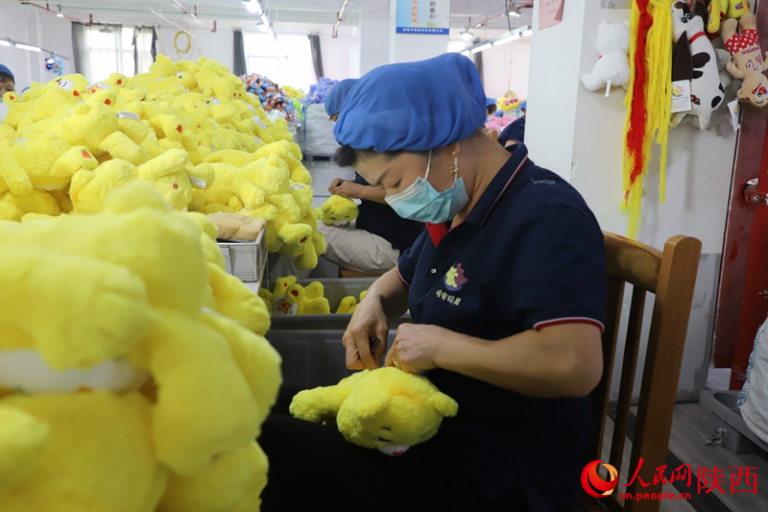
By Zhang Tie, In the city of Ankang, located in the south part of northwest China’s Shaanxi province, a burgeoning plush toy industry has taken shape, one that’s bringing economic vitality and abundant employment opportunities.
Each day, over 30,000 of these plush toys are “born” at the factory, a testament to the remarkable growth of Ankang’s plush toy industry.
It was on Jan. 23, 2018, that the first “made-in-Ankang” plush toy rolled off the production line. Yet, in just over five years, the city has attracted more than 800 related enterprises, providing nearly 20,000 jobs and generating an annual output exceeding 6.1 billion yuan ($844.1 million). This has made the city one of China’s four major plush toy production hubs.
The success of an industry in a particular location depends on how well it aligns with the local conditions.
Situated in the Qinling-Bashan mountainous region, Ankang has seen nearly one million people relocate from the mountains to urban communities as part of various resettlement and poverty alleviation programs.
The plush toy industry, which can absorb a large labor force, provides an ideal opportunity for these relocated residents to find stable employment and increase their incomes.
Additionally, Ankang is an important water conservation area for the South-to-North Water Diversion Project, and the plush toy industry perfectly meets environmental protection standards.
By capitalizing on these local conditions and matching supply with demand, the plush toy industry naturally became an eco-friendly industry that creates benefits for the people in Ankang.
In the factory of Shaanxi Hengtong Fiber Ecotechnology Co., Ltd.(Hengtong Fiber), discarded plastic bottles are transformed into soft, cotton-like PP (polypropylene) filling material for plush toys.
In the past, Ankang lacked the capability to produce this crucial stuffing material locally. However, in March 2021, the establishment of Hengtong Fiber extended the plush toy industrial chain in Ankang, reducing transportation costs for raw materials by 5 percent and enhancing the overall efficiency of the industrial cluster.
Today, the cluster encompasses upper-stream sectors like filling cotton, fabrics, buttons, and decorations. It also branches into trendy collectibles, cultural tourism, and intellectual property (IP) development.
The growth of the plush toy industry has extended the supply chain, streamlined logistics, and built a comprehensive value chain. Integrating this “chain-based” philosophy throughout the development process, while pooling industry resources and cultivating an industrial cluster has undoubtedly been a valuable experience for Ankang.
For an industry to progress and expand, continuous innovation is essential. In Ankang, enterprises have developed new materials and varieties of plush toys by utilizing locally abundant resources such as silkworms and moso bamboo. Collaborating with renowned museums and scenic spots, the city has launched special IP development projects that combine plush toys with cultural and creative products. Additionally, industrial tourism routes have been introduced, featuring plush toy plazas, themed hotels, and themed blocks, providing visitors with an immersive and memorable experience.
By staying attuned to industry trends, increasing research and development investments, and continuously improving innovation capabilities, Ankang has managed to stand out in the fierce market competition.
The rapid transformation of Ankang into China’s fourth-largest plush toy production base within just a few years can be attributed to the synergistic efforts of both “visible and invisible hands,” namely the functions performed by the government and the decisive role played by the market in allocating resources.
In October 2017, after conducting research, a poverty alleviation working group in Ankang, part of a Jiangsu-Shaanxi Poverty Alleviation Cooperation Project, submitted a report recommending that Ankang seize the opportunity presented by the relocation of the plush toy industry and transform itself into a hub for creative toys. This report laid the foundation for the future development of Ankang’s plush toy industry.
The city has established a 100-million-yuan fund for supporting the cultural and creative plush toy industry, organized creative design competitions, built an innovation base for the cultural and creative plush toy industry, constructed a “dry port” and utilized the China-Europe freight train service to reduce logistics costs.
The prosperity of Ankang’s plush toy industry is exactly a result of a combination of external demand for industry relocation, internal demand for employment and wealth creation, and objective conditions for industrial development, as well as the decision made by local authorities to vigorously develop the industry.
By capitalizing on its resources, seizing market opportunities, breaking away from traditional industrial development paths, and embracing an innovation-driven development model, Ankang has successfully blazed a new trail in the plush toy industry, revitalizing the local economy and enriching its residents.










